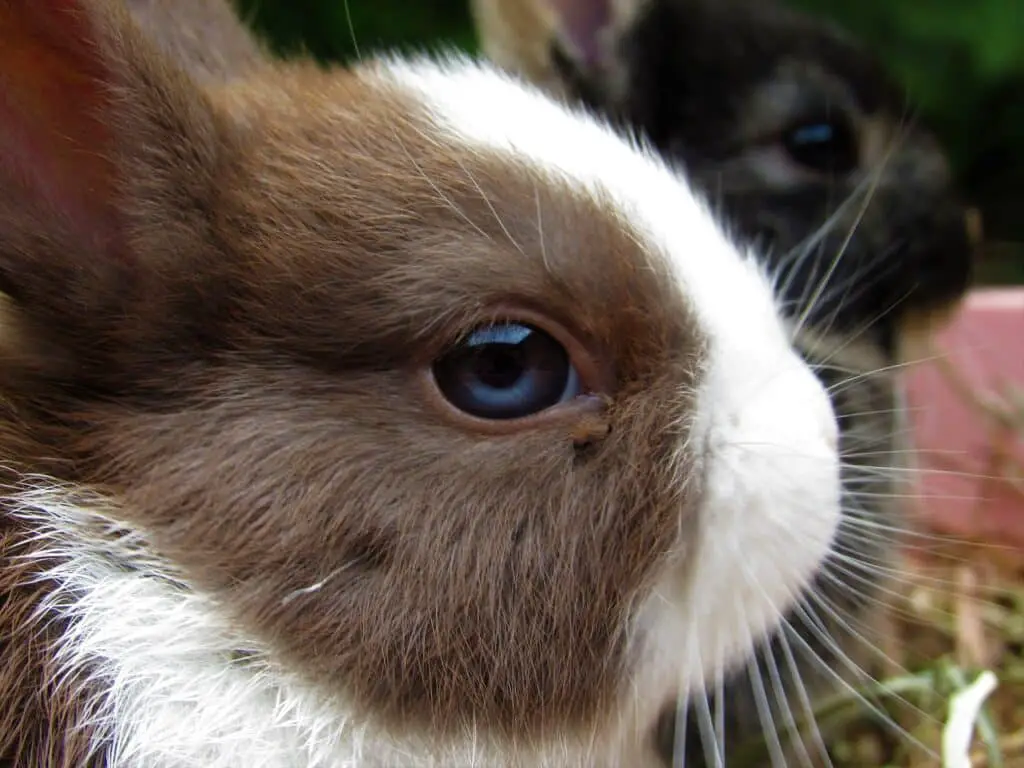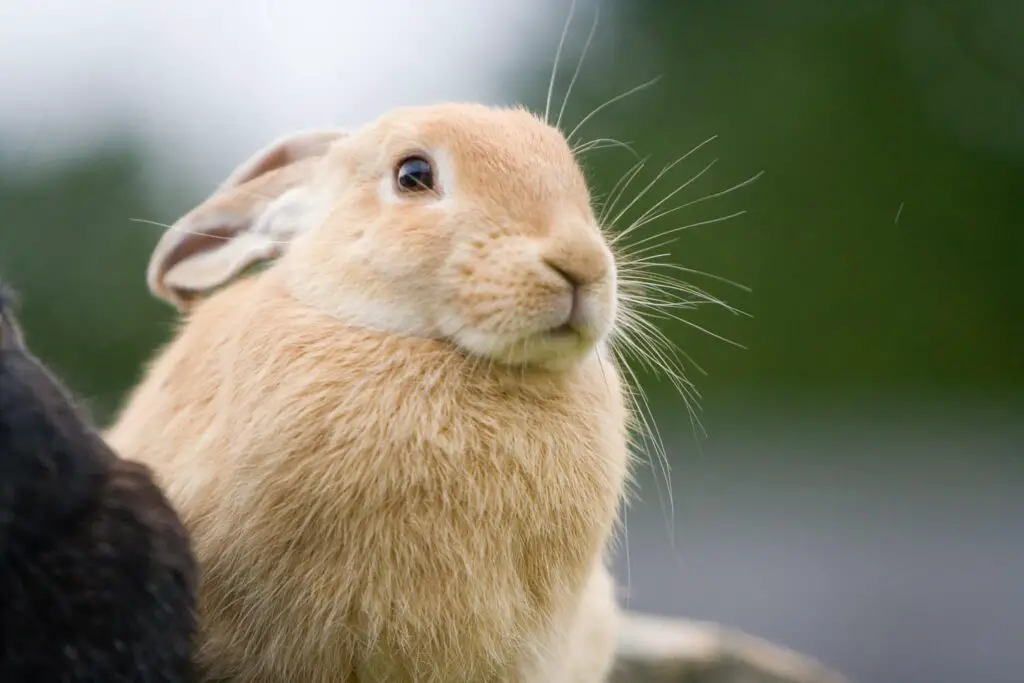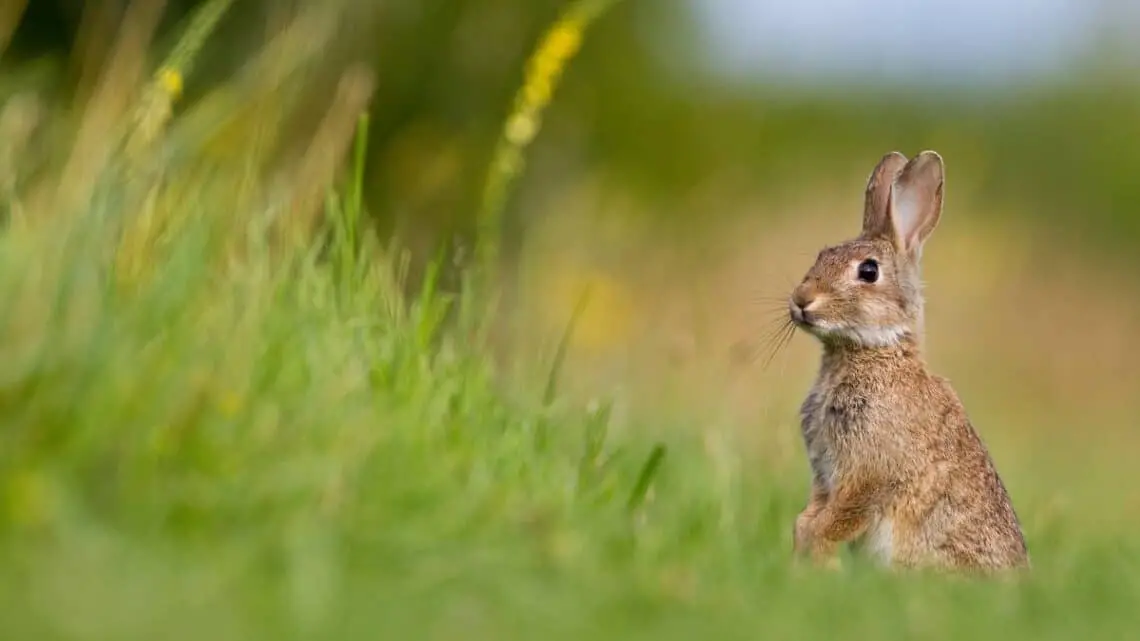Introduction
Do Rabbits Have Good Eyesight: The world of animals is a diverse and fascinating realm, encompassing creatures with a wide array of unique adaptations that enable them to thrive in their respective environments. Among these remarkable beings, rabbits have always held a special place, capturing the imagination of people across cultures. A fundamental aspect of any animal’s survival is its ability to perceive the world around it, and in the case of rabbits, their visual prowess is a subject of much intrigue. The question of whether rabbits have good eyesight delves into the intricate interplay between evolutionary biology, environmental niche, and the role of sensory perception in the lives of these small, enchanting creatures. Exploring the intricacies of rabbit vision unveils a world where adaptations to their surroundings have shaped their visual abilities, enabling them to navigate a complex web of challenges and opportunities in their quest for survival.
Rabbits, as prey animals, have evolved various adaptations to help them survive in their natural habitats. Their eyesight is a crucial aspect of these adaptations. While it’s not accurate to say that rabbits have exceptional eyesight in all aspects, they do possess certain characteristics that are well-suited to their ecological niche. Rabbits have large, protruding eyes blink on the sides of their heads, providing them with a wide field of vision. This panoramic view is essential for detecting potential predators approaching from various angles. However, this positioning also creates a small blind spot right in front of their noses, which is a trade-off for their expanded peripheral vision.
Many rabbit species are crepuscular or nocturnal, meaning they are most active during dawn, dusk, or nighttime. To accommodate this lifestyle, their eyes have adapted to low light conditions. Rabbits possess a high number of rod cells in their retinas, which are specialized for detecting light and motion. This abundance of rod cells allows them to see relatively well in dim lighting.While not as well-developed as that of humans, rabbits do have color vision. They can see a limited range of colors, with a preference for blues and greens. This ability to differentiate colors helps them identify ripe fruits and safe vegetation to consume.

How good is a rabbit’s eyesight?
Compared to humans, rabbits have more rods than cones in their retinas. This means rabbits can see better than we can in the dark but are limited to two-color vision. For example, they can distinguish between green and blue but cannot see red.
Visual Anatomy and Adaptations
Rabbits have evolved specific anatomical features that contribute to their impressive eyesight. Their eyes are positioned on the sides of their heads, providing them with a wide field of view that spans almost 360 degrees. This unique arrangement allows them to detect predators or potential threats from virtually any direction, minimizing blind spots and enhancing their overall awareness of their surroundings.
Moreover, rabbits are crepuscular animals, meaning they are most active during the dawn and dusk hours. This activity pattern aligns with their specialized eyesight adaptations, as their eyes are adept at adjusting to varying light levels. A high number of rod cells in their retinas help them perceive even low levels of light, aiding their vision during the dimly lit times of day.
Acute Vision
Rabbits are known for their acute vision, particularly when it comes to motion detection. This ability is a result of their visual system’s design, which prioritizes sensitivity to movement—a critical aspect of their survival strategy. Their eyes are equipped to detect even slight changes in their environment, allowing them to quickly identify potential threats and respond accordingly, whether it’s a predator approaching or a change in their surroundings.
Color Vision
While rabbits do possess color vision, it’s not as developed as that of humans. They are considered dichromatic, meaning they primarily perceive colors in the blue and green spectrum. This adaptation is suited to their natural habitats, as it helps them differentiate between various shades of green in vegetation and spot potential food sources or hiding places.
Depth Perception and Visual Accuracy
Depth perception is crucial for animals to accurately judge distances and navigate their surroundings. While rabbits’ eyes are positioned on the sides of their heads, which can sometimes affect their binocular vision (the ability to perceive depth by merging the slightly different images seen by each eye), they do have a degree of binocular overlap. This allows them to perceive depth to some extent, aiding them in activities such as jumping and landing accurately.
Challenges to Eyesight
Despite their exceptional eyesight, rabbits do face certain challenges. For instance, their wide field of view might make it difficult for them to focus on specific objects, especially those directly in front of them. Their eyes are more suited to detecting movement and changes in the environment rather than detailed close-up vision.
Can rabbits see better than humans?
The rabbit retina has a much higher ratio of rods to cones than the human retina has. Although a rabbit can see better than a human in low light conditions, his low light image has much poorer resolution (clarity) than the daytime images formed by your cone-rich, primate retina.
Field of View and Peripheral Vision
Rabbits are known for their wide field of view, often nearly 360 degrees due to the positioning of their eyes on the sides of their heads. This adaptation allows them to detect threats or predators from almost any direction, making them incredibly vigilant creatures. In contrast, humans possess a field of view that’s more limited, spanning around 180 degrees. While rabbits excel in peripheral vision, humans have a greater ability to focus on objects directly in front of them.
Low Light Sensitivity
Rabbits are crepuscular animals, meaning they are most active during dawn and dusk. Their eyes have evolved to be highly sensitive to low light conditions, aided by a high number of rod cells in their retinas. This adaptation grants them a superior ability to navigate their surroundings in dim lighting. Humans, while not as adept as rabbits in low light conditions, possess a relatively versatile range of light sensitivity thanks to the combination of rod and cone cells in our retinas.
Motion Detection and Acute Vision
Rabbits have a remarkable talent for detecting motion, which is crucial for their survival in the wild. Their eyes are finely tuned to spot even the slightest movement, allowing them to quickly identify predators and react accordingly. On the other hand, while humans possess the ability to detect motion, our vision is more geared towards perceiving fine details and colors. Our acute vision aids tasks such as reading, identifying distant objects, and discerning intricate patterns.
Color Perception
Humans are known for their trichromatic vision, capable of perceiving a wide range of colors across the visible spectrum. Rabbits, however, are dichromatic, with a more limited color perception that primarily includes shades of blue and green. While this might suggest that humans have a superior color vision, it’s important to note that rabbits’ visual adaptation aligns with their natural habitats, allowing them to effectively spot food sources and predators in their environments.
Visual Acuity and Detail
When it comes to visual acuity and detail, humans have the upper hand. Our eyes are equipped with a higher concentration of cone cells, which are responsible for detailed vision and color discrimination. This advantage allows us to engage in tasks that require precise recognition of fine details, such as reading, painting, and appreciating intricate artwork.
Do rabbits have good eyesight at night?
Yes, rabbits can see in the dark, but not very well. Their eyesight works best in the low light of dawn and dusk. Similar to human eyes, a rabbit’s vision will adjust to the conditions. They will be able to easily discern movement in the dark, but will also rely on their other senses, like smell and hearing.
Creeping Out at Twilight
Rabbits are classified as crepuscular animals, which means they are most active during the dawn and dusk hours. This activity pattern allows them to avoid the intense heat of the day while taking advantage of the relatively low light conditions of early morning and late afternoon. While not fully adapted to true nocturnal life, rabbits have evolved specific visual features that enhance their ability to function effectively during these twilight hours.
Adaptations for Low Light
One of the key factors contributing to rabbits’ ability to see well at night is their eye structure. Their eyes are proportionally larger compared to their head size, allowing more light to enter the eye. Additionally, they possess a high density of rod cells in their retinas. Rod cells are specialized photoreceptor cells that are extremely sensitive to light and excel in detecting motion and contrast. This abundance of rod cells gives rabbits an edge when it comes to perceiving movement in low light conditions, making them highly vigilant against potential threats from predators.
Enhanced Sensitivity
Rabbits’ eyes are remarkably adapted to adjusting to changing light levels. Their pupils can quickly dilate and constrict to allow more or less light to enter the eye, optimizing their vision for the surrounding environment. This adaptability ensures that they can still perceive their surroundings even as the light gradually fades during dusk or emerges during dawn.
Limited Color Perception
While rabbits possess several adaptations that aid their night vision, it’s important to note that their color perception is somewhat limited in low light conditions. They primarily see in shades of blue and green, which is well-suited for detecting contrast and movement but might not be as advantageous for distinguishing between colors during the night.
Balancing Act
Despite their night vision adaptations, rabbits still face challenges when it comes to navigating in the dark. Their eyes are positioned on the sides of their heads to provide a wide field of view, which can make it difficult for them to focus on objects directly in front of them. This arrangement is more suited for detecting predators from various directions rather than detailed close-up vision.
What do rabbits vision look like?
Compared to humans, rabbits have more rods than cones in their retinas. This means rabbits can see better than we can in the dark but are limited to two-color vision. For example, they can distinguish between green and blue but cannot see red.
Field of View and Panoramic Vision
Imagine a world where nearly everything around you is in view, without having to constantly turn your head. For rabbits, this is the norm. Their eyes are positioned on the sides of their heads, granting them an exceptional field of view that spans almost 360 degrees. This panoramic vision is an adaptation to their prey animal status, allowing them to detect predators from various angles and ensuring that they rarely have blind spots. However, this wide field of view comes at a cost, as rabbits might struggle with depth perception and focusing on objects directly in front of them.
Motion Detection and Sensitivity
The world as perceived by rabbits is one filled with movement and contrast. Their eyes are adept at detecting even the slightest changes in their environment. This ability is powered by the abundance of rod cells in their retinas, which are highly sensitive to light and excel at perceiving motion. This adaptation is a survival strategy, enabling them to quickly spot predators and respond with swift actions.
Colors in a Limited Palette
The colors that rabbits see are primarily limited to the blue and green spectrum. They have what’s known as dichromatic vision, which means they lack the full range of color perception that humans enjoy. This adaptation is aligned with their natural habitats, where being able to distinguish between shades of green and blue is crucial for identifying potential food sources and detecting predators hidden in the foliage.
Adaptation to Light Levels
Rabbit vision also shines in its adaptability to varying light levels. Their pupils can rapidly dilate and constrict, allowing them to adjust to changes in lighting conditions. This means they can navigate from the shadows of dawn to the glare of daylight with relative ease.
The Challenge of Binocular Vision
While panoramic vision is undoubtedly advantageous, rabbits sacrifice a bit of binocular vision— the ability to merge images from both eyes to perceive depth accurately. This is because their eyes are positioned on the sides of their heads. Despite this, they still possess some degree of binocular overlap, which helps them gauge distances, particularly when they’re navigating and leaping through their environments.
The Beauty of Twilight
As crepuscular animals, rabbits are most active during the early morning and late afternoon hours. This twilight lifestyle aligns perfectly with their visual adaptations. Their eyes are finely tuned to function optimally in low light conditions, making them adept at navigating their surroundings during these transitional periods between day and night.
Do rabbits have good eyesight?
Rabbits tend to be farsighted, which means they can see long distances really well. However, their vision for items nearby isn’t always so great. Part of the reason for this is the placement of the eyes on a rabbit’s head. Rabbits’ eyes are located high on the sides of the skull.
Panoramic Vision and Vigilance
Rabbits are known for their wide field of view, owing to the lateral positioning of their eyes on the sides of their heads. This unique arrangement grants them a near 360-degree vision, reducing blind spots and enabling them to detect potential threats or predators from almost any direction. This panoramic vision is essential for their survival as prey animals, allowing them to maintain a constant vigilance and swiftly react to any sign of danger.
Motion Detection and Sensitivity
A rabbit’s eyesight excels in detecting motion and contrast, thanks to their abundant rod cells. Rod cells are specialized photoreceptors that are exceptionally sensitive to light changes and excel in low-light conditions. This adaptation equips rabbits with the ability to perceive even subtle movements in their environment, making them adept at spotting predators or any alterations in their surroundings.
Adaptation to Low Light
Rabbits are crepuscular creatures, meaning they are most active during the twilight hours of dawn and dusk. To thrive in these low-light conditions, their eyes have evolved to be highly sensitive to changes in lighting. The rapid dilation and constriction of their pupils enable them to adapt quickly to varying levels of light, allowing them to navigate effectively during the transitional periods between day and night.
Limited Color Vision
While rabbits possess many strengths in their eyesight, their color perception is relatively limited compared to humans. They are dichromatic, perceiving colors primarily in the blue and green spectrum. This adaptation is well-suited for their natural habitats, where distinguishing between various shades of green vegetation and detecting subtle movement are of paramount importance.
Depth Perception and Binocular Vision
One area where rabbit eyesight might be somewhat less advanced is in depth perception. Their wide-set eyes, while providing an exceptional field of view, may impact their binocular vision—the ability to merge images from both eyes to perceive depth. Despite this, rabbits still possess a certain degree of binocular overlap, aiding them in estimating distances, especially when they need to make precise leaps or movements.
Visual Acuity and Focusing
While rabbits have several visual adaptations that make their eyesight impressive, they might not excel in close-up vision or focusing on fine details. Their eyes are more attuned to perceiving movement and changes in the environment, rather than scrutinizing objects up close.
What color do rabbits see?
Evidently, they can discriminate between the wavelengths we call “green” and “blue.” Although rabbits may not perceive green and blue the way we do, they *can* tell them apart. This means they have limited color vision, probably conferred by two different categories of cone cells (blue and green).
Dichromatic Vision
Rabbits are considered dichromatic, meaning they possess two types of color receptors or cones in their retinas. These cones are sensitive to specific wavelengths of light, allowing them to perceive a limited range of colors. Unlike humans, who are trichromatic and can perceive a wide spectrum of colors, rabbits are limited to distinguishing between shades of blue and green.
The Blue-Green Palette
The color palette that rabbits perceive is predominantly within the blue and green range of the spectrum. This adaptation is well-suited to their natural habitats, which often involve open fields and green vegetation. The ability to discern variations in these colors helps them detect movement, spot potential food sources, and identify hiding places or predators among the foliage.
Seeing the World in Contrast
While rabbits might not see the vibrant array of colors that humans do, their visual system excels in detecting contrast and movement. Their eyes are equipped with a high number of rod cells, which are specialized photoreceptor cells responsible for low-light vision and motion detection. This adaptation aligns with their crepuscular nature, as they are most active during the dim light of dawn and dusk.
Impact on Their Behavior
The limited color perception of rabbits has significant implications for their behavior and survival. Their focus on detecting movement and contrast enables them to swiftly respond to potential threats or changes in their environment. In the wild, their ability to spot predators against the backdrop of green vegetation or differentiate between shades of grass can mean the difference between life and death.
Adaptation to Their Habitat
Rabbits’ color perception is a testament to the intricacies of evolution and adaptation. While their vision might seem limited compared to ours, it is perfectly tailored to their ecological niche. In the grassy landscapes where rabbits forage and hide, their blue-green color perception helps them blend in with their surroundings and efficiently locate the resources they need.
Can rabbits see in dark?
Rabbits can see in the dark. Because they are crepuscular – meaning that they are most awake and alert at dawn and dusk – rabbits have evolved to see very well in low-light conditions. This helps them to forage for fresh grasses and weeds, even while the sun is barely up.
Crepuscular Creatures
First and foremost, it’s important to note that rabbits are considered crepuscular animals. This means they are most active during the twilight hours of dawn and dusk. While they aren’t fully adapted to true nocturnal life, their behavior aligns with periods of lower light levels. This adaptation allows them to avoid the intense heat of daytime while still capitalizing on the relative cover of darkness.
Rod Cells and Low-Light Sensitivity
Rabbits possess an abundance of rod cells in their retinas. Rod cells are specialized photoreceptor cells that are extremely sensitive to light, especially in low-light conditions. This adaptation equips rabbits with the ability to perceive movement and changes in their environment even when the light is dim. It’s this sensitivity to light changes that allows them to detect predators or any other potential threats lurking in the shadows.
Pupil Adaptation
Another way rabbits enhance their vision in low-light conditions is through the adaptability of their pupils. Their pupils can dilate (widen) and constrict (narrow) rapidly, which allows them to adjust to changes in lighting levels. This ability is crucial for their crepuscular lifestyle, as it enables them to swiftly transition between the dim light of dawn and dusk.
Color Perception in the Dark
While rabbits have adaptations that enhance their vision in low light, their color perception is somewhat limited. They primarily see in shades of blue and green due to their dichromatic vision. This adaptation is aligned with their natural habitats, where the ability to detect contrast and movement, rather than a full range of colors, is more crucial for survival.
Binocular Vision and Depth Perception
While rabbits have remarkable adaptations for vision in the dark, their binocular vision (the ability to perceive depth by merging images from both eyes) might be somewhat compromised. Their eyes are positioned on the sides of their heads, providing them with a wide field of view. However, this arrangement can affect their depth perception, as it might be more challenging for them to focus on objects directly in front of them.
Can my rabbit see me?
Rabbits can see all around them without turning their head at all. This includes being able to see any predators sneaking up behind them. In fact, rabbits have an almost 360 degree field of vision, including the area above their head. They only have one blind spot, located directly in front of their nose.
Visual Adaptations of Rabbits
Rabbits possess a set of visual adaptations that shape how they perceive the world, including you. Their eyes are situated on the sides of their heads, granting them a wide field of view that spans nearly 360 degrees. This design allows them to be highly vigilant and detect potential threats or predators from various directions, a critical trait for a prey species.
Perceiving Motion and Contrast
Rabbits are particularly adept at detecting movement and changes in their environment. Their eyes are equipped with an abundance of rod cells, which are specialized photoreceptor cells that excel at perceiving motion and contrast. This adaptation means that when you move or there’s any change in your surroundings, your rabbit is likely to notice.
Seeing in Color, with Limitations
Rabbits are dichromatic, which means they primarily perceive colors in the blue and green spectrum. Their color vision is adapted to their natural habitats, allowing them to differentiate between shades of green and blue. While they might not perceive the full spectrum of colors like humans do, they can still distinguish between various shades and perceive contrasts.
Your Rabbit’s Perception of You
When it comes to how rabbits see you, there’s a good chance that they can perceive your presence and movements quite well. They might not see you in the same way that humans see each other, but their acute motion detection and sensitivity to contrast allow them to notice when you enter their field of view, move around, or interact with them.
Establishing Trust
Rabbits are prey animals, which means they’re naturally cautious and attuned to the movements of potential predators. Building a bond of trust with your rabbit involves understanding their natural behaviors and communicating with them in ways that make them feel secure. Slow, deliberate movements and gentle interactions can help them associate your presence with safety and comfort.

Conclusion
The question of whether rabbits have good eyesight reveals a fascinating blend of adaptations that have evolved over time to suit their particular ecological role. While not characterized by the same high level of visual acuity as some predators, rabbits possess a set of visual attributes that are well-matched to their role as prey animals. Their large, protruding eyes grant them a wide field of vision, aiding in the detection of potential predators from various angles. Their exceptional rod cell density equips them for nocturnal and crepuscular activity, allowing them to navigate low-light conditions adeptly. Additionally, their capacity to detect motion swiftly and judge distances, alongside a limited yet functional color vision, contribute to their survival strategies.
The evolutionary journey of rabbits and their eyesight highlights the remarkable ways in which animals adapt to their environments. Their vision reflects a balance between identifying threats and locating resources, providing a lens through which we can appreciate the intricacies of nature’s design. While “good eyesight” might vary depending on the context, for rabbits, their visual capabilities are undoubtedly finely tuned to their survival needs. This exploration underscores the beauty of diversity in the animal kingdom and serves as a testament to the complexity of life’s adaptations.





No Comments